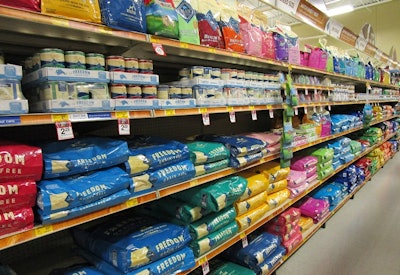
If you needed further proof that pet food and other pet products are an integral part of today’s economy, consider this: 66 of the top 100 US retailers now carry pet products, according to an analysis by John Gibbons on PetBusinessProfessor.com. For his in-depth look at this retail environment, he used data from the US Census Bureau’s Monthly Retail Trade report, then removed gas stations and restaurants, winnowing down the list to 88 retailers – meaning 93 percent of those sell pet food and other pet products.
And, among those 66 large retailers selling pet food and other products, only two – PetSmart and Petco – are specifically focused on pets. You could argue that a third, Tractor Supply Co., devotes a fairly significant share of its business to pet food sales. That leaves 63 retailers carrying numerous other categories that consider pet supplies an important part of their product mix.
Some interesting data points and details:
- The total US retail market – all retailers and outlets – reached US$5.5 trillion in sales in 2016, with the top 100 accounting for US$2.07 trillion, or 37.6 percent.
- In terms of growth, total retail sales increased 3.2 percent (up from 2.3 percent in 2015), while the top 100’s sales grew 3.5 percent (down from 4.9 percent in 2015).
- The 66 retailers selling pet products had US$1.77 trillion in sales, or 32 percent of the entire US retail market. Those sales represented 3.7 percent growth over 2015 sales.
- The number of stores comprising those 66 retailers reached over 154,000, a 1.5 percent increase.
Focus on pet food and other pet products pays off
As a subset of the top 100, pet-focused retailers are enjoying growth, too. PetSmart, number 69 on the list, reached US$6.48 billion in sales in 2016, a 3.4 percent rise, and 1,403 stores, a 4.6 percent increase. Gibbons tracked the top 100 data back to 2013 to show that PetSmart’s growth in sales and stores the past three years was even healthier, at 9.3 percent and 12.5 percent, respectively.
Petco made the top 100 list for the first time in 2016, landing at number 98 with US$4.02 billion in sales and 1,489 stores. While its data going back to 2013 wasn’t available, the chain registered 4 percent growth in both sales and stores from 2015 to 2016.
Since Tractor Supply carries a large number of pet food brands as part of its product mix, I’ll include its data: a rank of 67 on the top 100 list, sales of US$6.78 billion and 1,738 stores in 2016. Those numbers represent very robust growth: 8.9 percent in sales and 16.8 percent in stores over 2015 and 31.3 percent and 36.2 percent, respectively, since 2013.
E-commerce’s role in US retailing
As Gibbons points out, these three retailers, along with the other 63 top retailers carrying pet products, are not the only places selling them. “They were the only companies to make the list. Pet products are sold in thousands of other retail outlets – 20,000 more grocery stores, 10,000 more pet stores, 16,000 vet clinics,” he writes. “A reasonable estimate would be that there are 200,000 outlets selling pet products in the US, plus the internet.”
Ah yes, the internet. Gibbons’ analysis breaks down the top retailers selling pet products in physical stores versus those selling online only, understanding that some (many?) of the brick-and-mortar stores also have online sales. The retailers with a physical presence number 54 and had US$1.6 trillion in sales and 138,000+ stores in 2016.
They enjoyed 3.1 percent sales growth over 2015, while the internet-only retailers carrying pet products saw a 9.3 percent increase in sales in 2016. That got them to a smaller sales total of US$185.5 billion, but the growth – US$15.8 billion – shows the increasing popularity of e-commerce among US consumers, for pet products and nearly every other product category. Though, it must be noted that Amazon accounted for 97.7 percent of that sales growth for online only retailers.
Interesting indicators for pet food retailing
This backdrop indicates that, for all the buzz it received, PetSmart’s acquisition of Chewy.com is fraught with all sorts of risks and unanswered questions. The main one: Can anyone, in any product category, really take on Amazon? Outside of China and its own online giant, Alibaba, that is. (Though the recent resignation of Michael Massey, PetSmart’s CEO, may have very well been planned from the beginning of his 2015 tenure, when BC Partners bought the retailer, and the Chewy acquisition was lauded by the owners, you have to wonder if there is more to the story.)
This retail backdrop also helps explain why fast-growing pet food companies like Blue Buffalo decide to expand into the mass market channel with some of their brands. While the company described its intentions to expand as only “incremental” beyond sales of its pet foods in pet specialty stores, it no doubt saw potentially healthy growth in selling to grocery store chains and other mass retailers. In fact, of the retailers named in the Blue Buffalo announcement, three are in the top 15 among the largest 100 US retailers – Kroger at No. 2, Target at No. 8 and Publix, 15 – while the fourth, Meijer, currently ranks as the 26th largest US retailer.
In an earnings call on August 8, Blue Buffalo CEO Billy Bishop said that the company’s sales growth in pet superstores was slowing. For the second quarter of 2017, Blue Buffalo’s pet superstore sell-through dropped about 6 percent year over year, while its sell-through rate outside of that channel was 30 percent. Bishop attributed much of the growth to e-commerce sales but also commented on the mass market expansion. “These four retailers account for approximately 8 percent to 9 percent of the US pet food market in dollar terms compared to our current distribution reach of approximately 40 percent. So, this is a significant expansion for us,” he said.
Rumors are swirling that other pet food companies are considering similar moves. If Blue Buffalo’s expansion pays off with increased sales or market share, we can probably expect that to happen as pet food and pet supplies become an ever-important contributor to the economy.



















